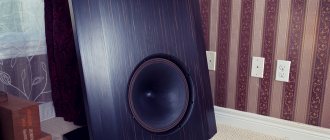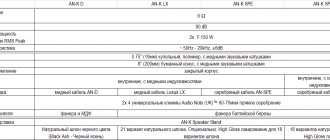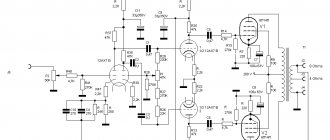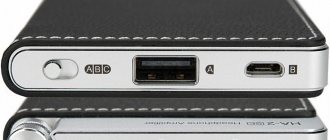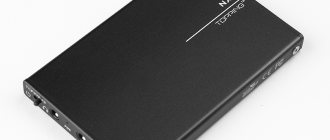Audio Note Component System
The company, led by Peter Qvortrup, has always been in implacable opposition to the audio mainstream, adhering to its own, clearly defined principles. Perhaps that’s why the sound of Audio Note leaves no one indifferent - they either don’t accept it at all, or they get hooked for life.
This is not the first time we have tested Audio Note equipment; we had a chance to visit the factory and talk to Peter. At first glance, its concept is quite simple in words: in the amplification path there are only tube triodes, kenotron rectifiers with chokes, extremely laconic circuit design without feedback, the most careful selection of components according to their contribution to the sound and skilled manual work. In practice, everything is not so smooth - uncompromising technology turns out to be heavy, bulky and by no means cheap.
To everything mentioned above, we can add that Peter categorically does not accept cathode followers (like cascades with OS), but considers it necessary to achieve a minimum output impedance of sources and preamplifiers. Conflicting requirements leave him with no other options other than linear output transformers. They are also used in many developments for communication between cascades.
-Five CD transport, the mentioned principles are implemented to the maximum - its digital signal is supplied to the output through a tube transformer stage, which is powered by a kenotron rectifier. This uncompromising solution gives an output impedance of about 2 ohms, due to which, according to the developers, the accuracy of data transmission increases, and the quality of the digital cable practically does not matter. The disc is loaded from above, under the sliding flap, where the advanced Philips CD Pro2LF drive is suspended on spring shock absorbers. As with all Level 5 components, the internal wiring of the vehicle is made with AN Pallas silver cable, and the electrolytic capacitors in the power circuits are Rubycon Black Gate. The vehicle weighs about 22 kg.
Peter categorically does not accept cathode followers (like stages with OS), but considers it necessary to obtain a minimum output impedance of sources and preamplifiers.
DAC5 converter has even more transformers. One, with silver windings, receives the input signal, the second, on a core with colossal magnetic permeability, works as a current/voltage converter, and another one, silver, works in the anode of the 6463 output lamp. The analog filter is built on chokes, also with silver windings, and branded capacitors made of paper with copper foil and oil. Selected AD1865 DACs (18 bit/96 kHz) are responsible for the conversion; oversampling and digital filters are not used at all.
Another source in our system is the TT2 . Its design is designed so that external influences (sound waves from speakers, vibrations, etc.) are not transmitted to the record and pickup. The acrylic disk is driven by two motors mounted on a floating subchassis. The platform with the Arm Two tonearm is also attached to it. Head – Goldring Elite with moving coil. The signal from the player was fed to a step-up transformer AN-S3 .
The Meishu Phono integrated amplifier can be considered a classic of High End Audio. Single-ended direct-heated 300V output in “pure” class A, no feedback, kenotron power supply and audiophile components: tantalum, oil paper, black gates, silver acoustic terminals. The MM phono stage is built on dual triodes ECC83 and ECC88. Output power 2 x 9 W regardless of load resistance.
With such power, you need very sensitive acoustics, for example, Audio Note AN-E SPe HE . The last two letters mean High Efficiency, and this version of the monitors has a sensitivity of 98 dB. 8-inch midbass drivers made from hemp fibers and paper pulp not only have an optimal stiffness-to-weight ratio, but also increased musicality. There are a lot of jokes about this on the Internet, but I must note that other manufacturers, for example, Sonus Faber, also use hemp in diffusers.
Selected AD1865 DACs (18 bit/96 kHz) are responsible for the conversion; oversampling circuits and digital filters are not used in principle.
The voice coils for both the midbass and tweeters are silver, as is the internal wiring, and the four input terminals are coated with a thick layer of silver. The bands are divided quite low for a two-way design - at 2 kHz. Heads for the right and left columns are selected in pairs using a special computer program. The bass reflex port, the port of which is located on the rear wall of the case, made it possible to lower the lower limit of the operating range to 34 Hz (-3 dB).
Cases made of multi-layer birch plywood are finished with natural veneer and are also painted in various colors; The number of design options has now reached twenty. Judging by the inscription on the nameplate, our pair was made in Austria, the quality of its finishing (zebrano veneer with varnish) is impeccable.
Audio Note's sound rarely makes an impression from the first minutes, but if you don't get distracted and sit in front of the system thoughtfully for ten minutes, it's really addictive. And you can’t immediately tell what exactly it is, it seems too integral and balanced. Which is not surprising - after all, all components are made according to a single, strictly observed ideology. But I’ll still try to analyze it, and first of all I’ll note the bass and lower mids. We decided not to place the speakers in the corners of the room, as the manufacturer recommends, and were rewarded with, if not super-deep, but extremely intelligible and not at all heavy lower register. This is the beauty of lightweight diffusers - there is no rubbery ductility, every note is traced, the attack is fast, light, but the drum beat is also like a real one - energetic, juicy, with a full spectrum, and not a disembodied shell, which is sometimes presented by highly sensitive acoustics.
Another point is the sound character of Meishu Phono. I had a chance to listen to a lot of 300V single-ended speakers, and almost all of them, regardless of price, sounded somehow relaxed, soothing. In Meishu, this character trait is present to a minimal extent, and it boils down to the absence of aggression and the most comfortable presentation of musical material. I once asked Qvortrup why he publishes the circuits of his amplifiers, because they are simple and can be repeated even by not very experienced amateurs. To which he replied: “They will still come to me for components, without them the Audio Note sound will not work.” Meishu is able to please fans of opera, small jazz ensembles, blues and a host of other genres, with the possible exception of hard rock and drum and bass. For this type of music, Audio Note has other offerings.
There is no rubbery ductility, every note is traced, the attack is fast, light, but the drum beat is like a real one - energetic, juicy, with a full spectrum.
As for the source, there were no questions about it at all. With resolution, musical balance, separation of instruments and “air” - not the slightest problem. The sound is not analog, but not ordinary digital either - smooth, with a lot of details and subtle tonal shades. In short, purebred and musical. You put on the disc and listen from beginning to end.
Vinyl reproduction is typically “audionote” - with an emphasis on mid-range information, live vocals and spaciousness. The phono preamplifier circuit in Meishu is the same as that of the pre-M3, with passive correction on selected parts. Hence the sound - extremely detailed, but not tiring.
The sound is not analog, but not ordinary digital either - smooth, with a lot of details and subtle tonal shades.
By selecting cables in this system, it is possible to increase contrast in the high range and achieve greater depth of the scene, as demonstrated by a demonstration at the recent MHES exhibition. But the basic level of the system is so high that tweaking can only slightly spice up the sound to your liking. But it’s unlikely to spoil it.
SYSTEM
- Turntable TT-2 with Arm Two tonearm and Goldring Elite head (113400 + 82300 + 57000 RUR)
- Step-up MC transformer AN-S3 (RUB 204,300)
- CD transport CDT5 (RUB 2,975,000)
- Digital-to-analog converter DAC5 (RUB 2,915,000)
- Meishu Phono integrated amplifier (RUB 544,900)
- Speaker systems AN-E SPe HE (RUB 510,800)
- Cables: - digital Cardas Precision
- — interblock AN-V
- — acoustic SP-X
share
Tags: AN-E SPe HEArm TwoAudio NoteCardasCDT5DAC5Goldring EliteMeishu PhonoPeter QvortrupFT-S3
Audio Note DAC 3.1xV2 Balanced
Audio Note is the only high-end company in the world to design and manufacture complete analogue and digital audio reproduction systems entirely in-house. Audio Note's range of products includes cartridges, tonearms, digital-to-analog converters, preamps and amplifiers, speakers, speaker stands and cables, plus a wide selection of carefully selected high-quality components. Each individual component is subject to the same sound quality assessment criteria, meaning that all components produced by Audio Note will always be fully compatible with each other. The company's owner, internationally recognized audio guru Peter Qvortrup, views the sound reproduction system as a single whole, in which complementary design parameters and their implementation lead to an incredible level of emotional involvement and pleasure from music, unattainable in other systems. Music reproduction by a speaker system produced by Audio Note defies standard description, since it differs significantly from the traditional one to which home listening enthusiasts are accustomed. In these products we encounter sound of a completely different nature, due to the fact that throughout the entire path the signal is amplified only by lamps. Audio Note differs from other companies producing tube equipment in that all its components, from CD transport to speaker systems and cables, are developed and manufactured in-house, and therefore are perfectly harmonized. All components, like the instruments of a symphony orchestra, are selected and tuned to achieve the ideal reproduction of music. The result is the absence of tonal coloration of the sound and the most detailed presentation of the phonogram. A percentage of musical information is extracted from the recording that a true music lover could only dream of. When compiling a kit, it is necessary to select devices, cables, and speaker systems of the appropriate level. Audio Note differs from other companies producing tube equipment in that all its components - from CD transport to speaker systems and cables - are developed and manufactured in-house and are initially perfectly coordinated and harmonized. All components, like the instruments of a symphony orchestra, are selected and tuned to achieve perfect music reproduction. The result is a complete absence of tonal coloration of the sound and a most detailed presentation of the musical material. All audio devices manufactured by Audio Note have many modifications. Whether a particular modification belongs to a certain level is determined by the quality of the components, the type of transformer, lamps, the name of the cable and even the circuit design (one amplifier model can be either single-ended or push-pull, with balanced or unbalanced inputs or outputs). Audio Note AN integrated amplifiers, unlike products from most other companies, are combinations of a preamplifier and a stereo power amplifier, down to independent power supplies for these parts, but assembled in one housing. Audio Note preamplifiers are distinguished by unparalleled manufacturing quality. Higher-level products use oil-paper silver capacitors and tantalum resistors, and Black Gate electrolytic capacitors. Tube rectifiers are used in power circuits. The element that determines the sound are transformers of our own design using mu-metal additives, including those with silver windings. Audio Note power amplifiers are made without negative feedback in pure class A. The output stages also use transformers made using a unique technology using a mu-metal additive. In models of higher levels, the windings are made of silver wire, made by hand. Incredibly transparent sound helps to recreate the musical canvas with amazing accuracy, causing the listener to be emotionally involved in all musical events. Audio Note digital-to-analog converters are interesting due to their unique Direct From Disc technology. This so-called “single resampling” (the absence of a digital filter and any data stream conversion) allows for previously unattainable CD playback quality. High-end DACs use “magic” current-to-voltage converters made on silver transformers, as well as high-quality input, output and interstage transformers and tube rectifiers. With the advent of the Zero Level series, Audio Note's high-quality tube technology has become accessible even to the budget-conscious audiophile. Audio Note speaker systems are divided into three series. The first is Audio Note AX-One/Two/Three – bookshelf speaker systems; the second - Audio Note AZ One/Two/Three - floor-standing speaker systems; both lines are designed for Level Zero. The models included in the third, most numerous, series - Audio Note AN-K/J/E - have a similar design and differ in body sizes. Depending on the type of cable used in the internal wiring, the quality of the parts in the crossover filter and the type of speaker, these speaker systems are intended for levels from zero to five. The type of modification is indicated in the model name through a fraction.
